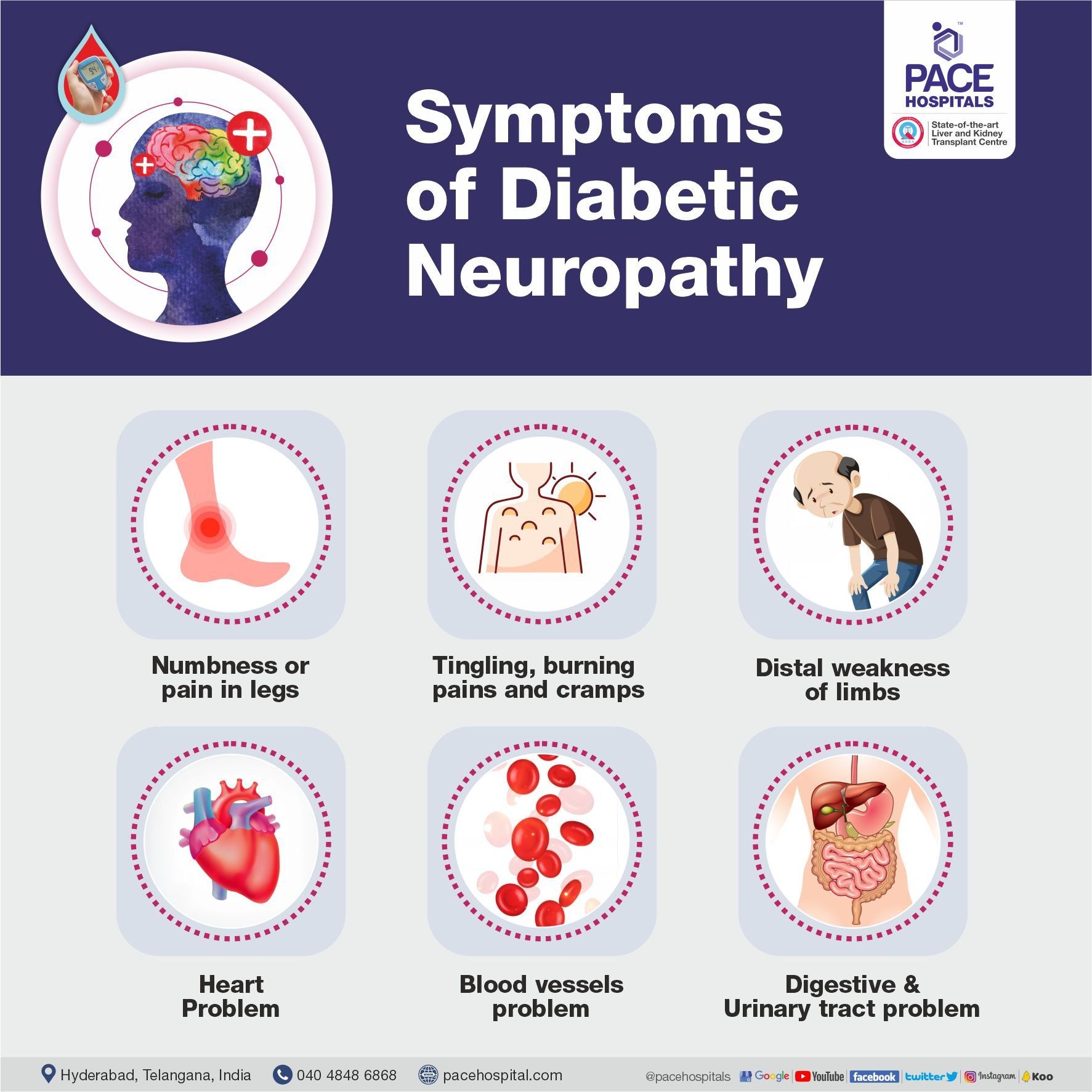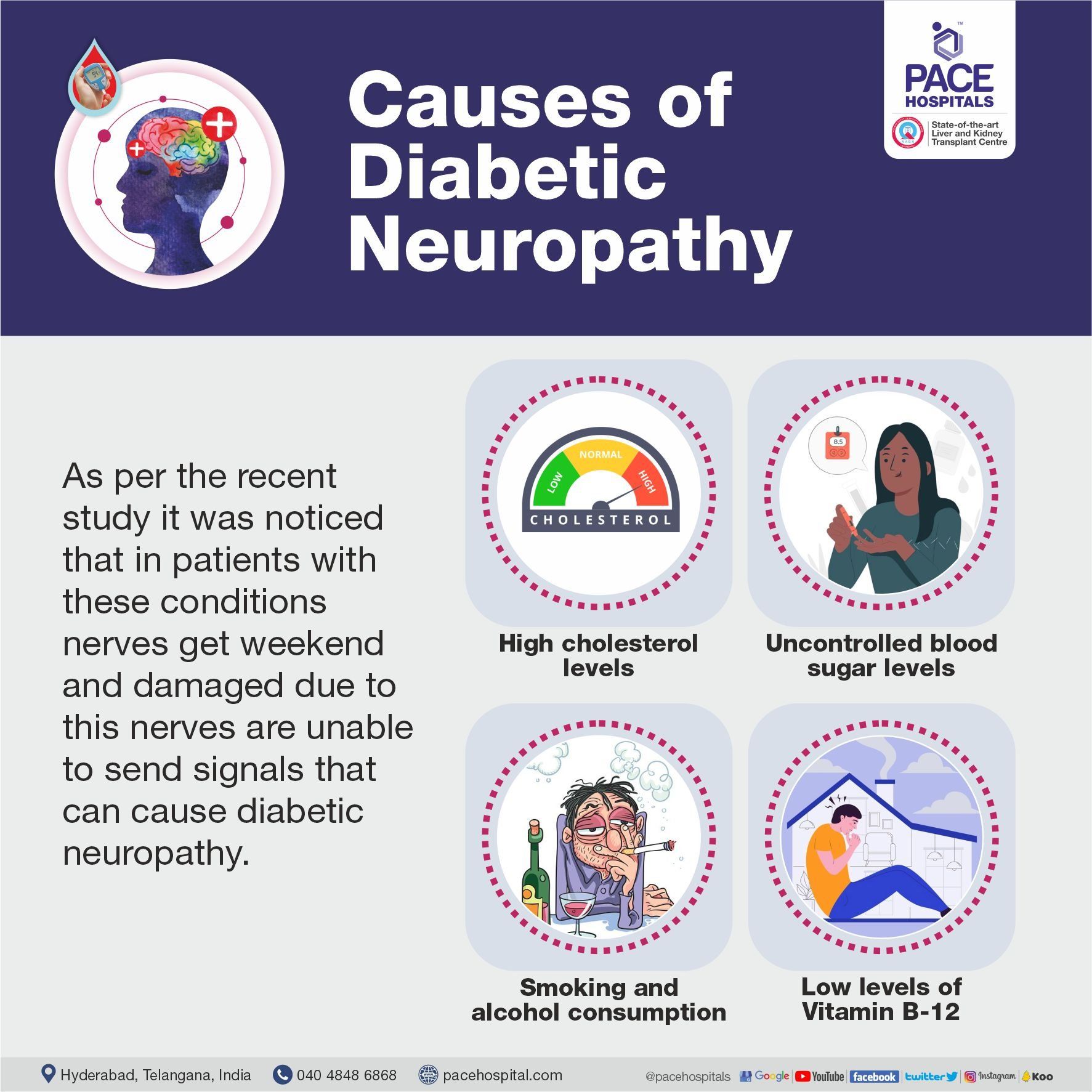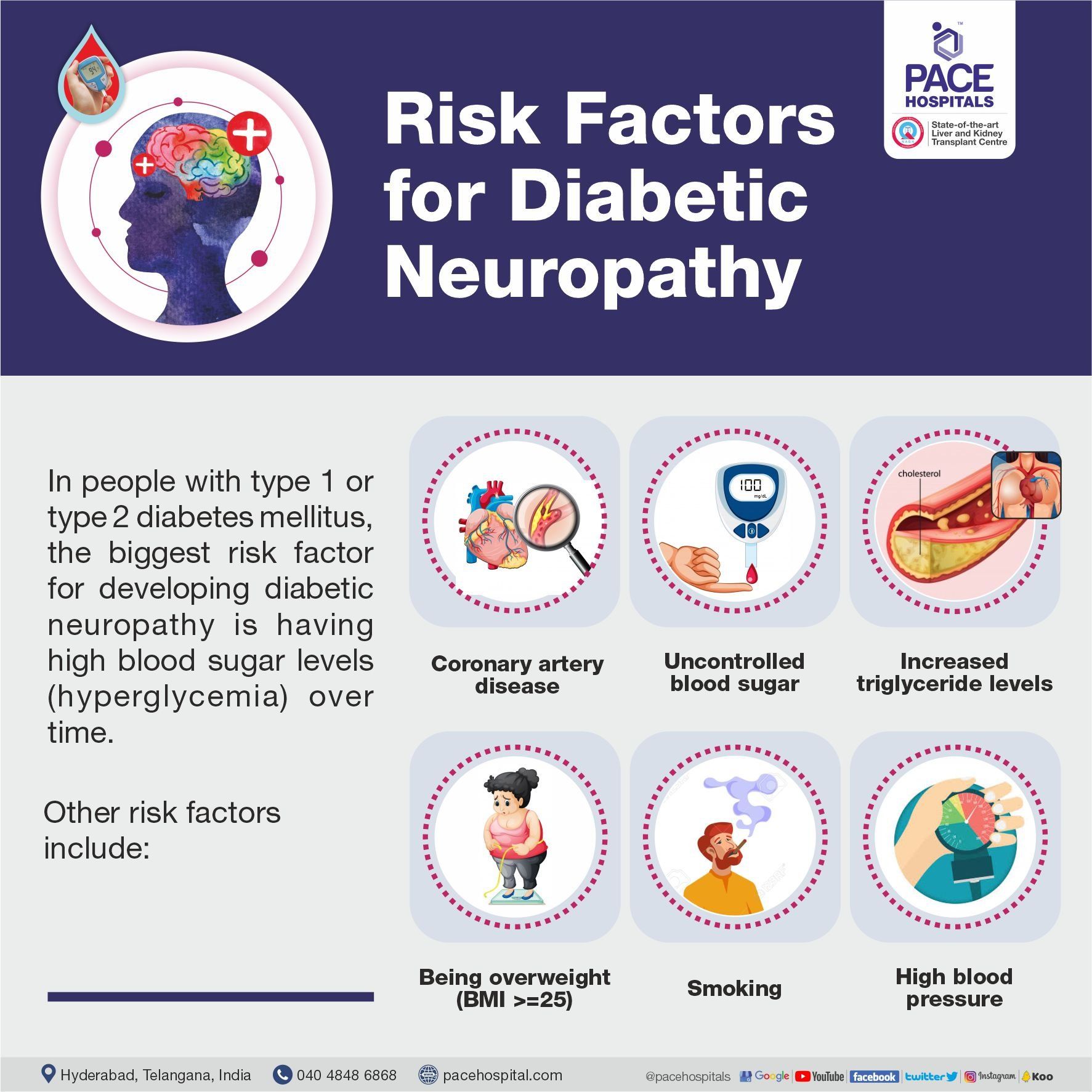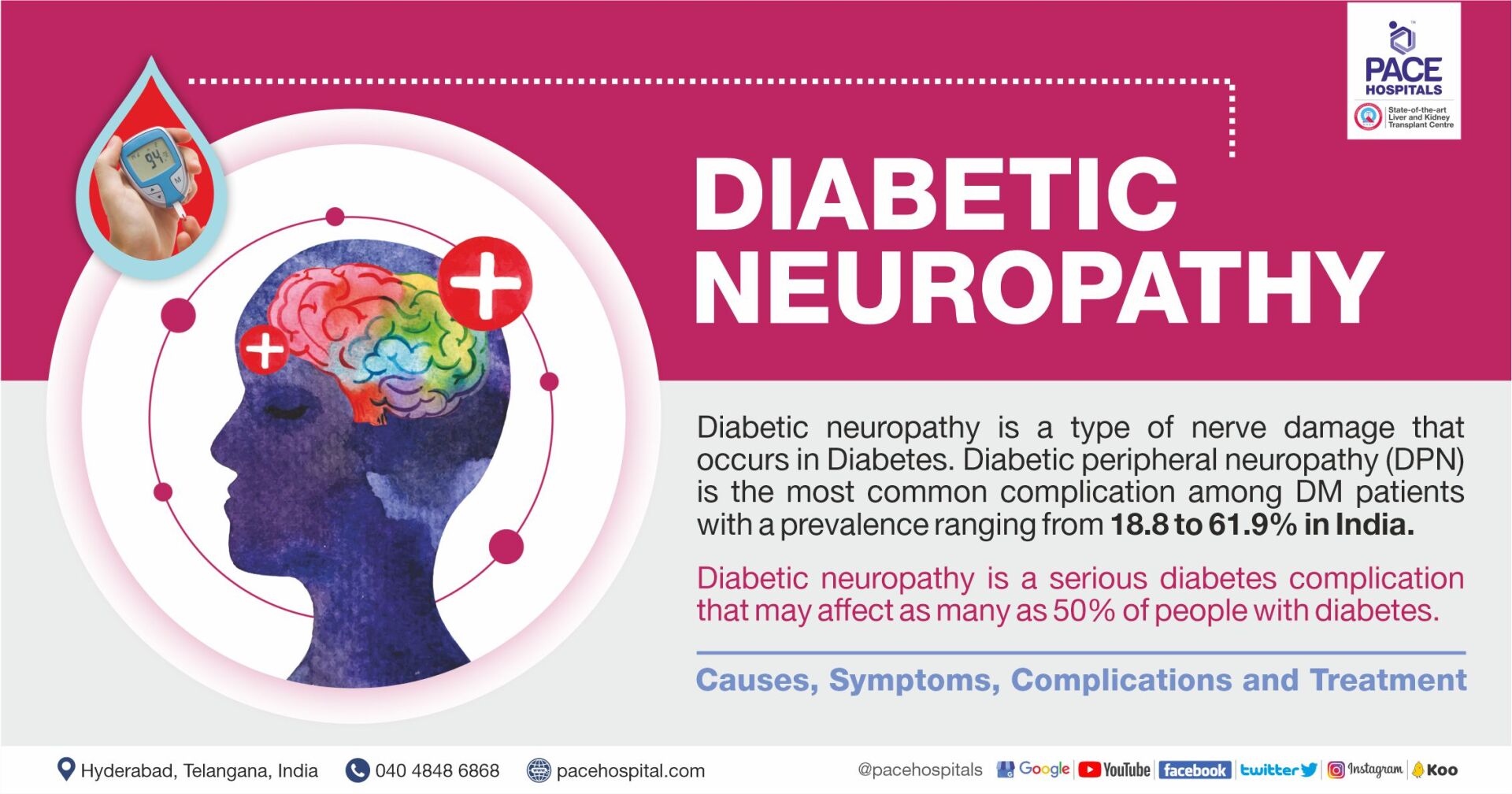Diabetic Neuropathy – Causes, Symptoms, Complications and Treatment
PACE Hospitals
What is Diabetic Neuropathy?
Diabetic neuropathy is a progressive disease and a serious complication of diabetes that occurs due to nerve damage. Uncontrolled high blood sugar (hyperglycemia) mainly affects the nervous system. Depending on nerves damage in the body symptoms may vary.
Nervous system are very essential in the human body that send messages or signal to organs and body parts to perform normal function such as breathing, walking, bodily functions, sense of touch and feel etc.
Prevalence of Diabetic Neuropathy
According to the International Diabetes Federation 2017 estimates, 425 million people are living with diabetes mellitus (DM) in the world. By 2045, the number is predicted to rise to 629 million people. India, in 2017, had 72,946,400 patients, the second-largest number of people living with diabetes. The current prevalence in India is 8.8%
Diabetic peripheral neuropathy (DPN) is the most common complication among diabetes mellitus patients, with a prevalence ranging from 18.8 to 61.9% in India. Early diagnosis of DPN can reduce associated complications.
DSPN (Distal symmetric polyneuropathy) constitutes the most common type seen in 50% of patients with Diabetic Neuropathy, CTS (Carpal tunnel syndrome seen) in 25%, Autonomic neuropathy in 7% and other types seen in 3% of patients that include Polyradiculopathies (Diabetic amyotrophy, Thoracic polyradiculopathy), Mononeuropathies (Cranial mononeuropathy, Peripheral mononeuropathy), Small fiber neuropathy, Treatment induced insulin neuritis, Diabetic cachexic neuropathy.
Types and Symptoms of Diabetic Neuropathy
The symptoms commonly seen in diabetic neuropathy are numbness or pain in legs or feet, tingling, burning pains and cramps, distal weakness of limbs, problems related to blood vessels, urinary tract, digestive system and heart. Symptoms like lightheadedness, excessive sweating, urinary incontinence, constipation, diarrhea, nausea, vomiting and sensation of fullness are observed in autonomic neuropathy.

Symptoms may vary based on the nerve damage in your body, you may not notice the symptoms till the considerable damage. There are mainly four types of Diabetic neuropathy:
1. Distal symmetric peripheral neuropathy
It is the most common type of diabetic neuropathy. Nerve damage usually affects the toes and feet first. Some people do not feel any symptoms, but other people can have symptoms which include:
- Numbness or loss of feeling.
- Burning or pain, which is often worse at rest or at night.
- Tingling
- Feeling light touches as bothersome or painful
- Sharp pains or jabs.
Diabetic neuropathy usually affects both sides of the body. Symptoms are often noticed in the toes. If the disease progresses, symptoms may gradually move up the legs; if the mid-calves are affected, symptoms may develop in the hands. This is called glove and stocking pattern of symptoms. Over time, the ability to sense pain may be lost, which greatly increases the risk of injury.
2. Autonomic neuropathy
The autonomic nervous system controls the eyes, heart, stomach, intestines, bladder, and sex organs. Diabetes can affect nerves in any of these areas, possibly causing:
- Bladder problems, including urinary incontinence or urinary retention.
- Constipation, uncontrolled diarrhea or both.
- Slow stomach emptying leading to nausea, vomiting, sensation of fullness and loss of appetite.
- Increased or decreased sweating. Sudden drop in BP when rise from sitting or lying down that may cause feeling light-headedness (orthostatic hypotension).
- Erectile dysfunction in men, vaginal dryness in women.
- Changes in the way eyes adjust from light to dark.
- Problems regulating body temperature.
3. Proximal neuropathy (Diabetic polyradiculopathy)
It is also called Diabetic amyotrophy, often affecting nerves in thighs, hips or buttocks or legs. It can also affect chest and abdominal area. Generally symptoms are on one side, but it may spread to the other side as well. Symptoms include:
- Severe pain in hip, thigh or buttock.
- Eventually weak and shrinking thigh muscles.
- Difficulty rising from a sitting position.
- Severe stomach pain
4. Mononeuropathy (Focal neuropathy)
It is of two types’ - cranial nerve mononeuropathy and peripheral nerve mononeuropathy.
Cranial mononeuropathy: affecting cranial nerves leading to symptoms like double vision due to 3rd or 6th nerve involvement or paralysis on one side of the face (bell’s palsy) due to 7th cranial nerve involvement.
Peripheral mononeuropathy: In this nerve involvement leads to entrapment neuropathy like carpal tunnel syndrome leading to symptoms like numbness or tingling in hand or fingers involving thumb, index and middle fingers and weakness in the hands causing things to drop.
Other types include:
- Small fiber neuropathy which involves severe burning paraesthesia in feet
- Treatment induced Insulin neuritis associated with paraesthesia with the initiation of insulin treatment
- Diabetic cachexic neuropathy commonly seen in men with weight loss and paraesthesia.
Causes of Diabetic Neuropathy

As per the recent study it was noticed that in patients with uncontrolled blood sugar levels nerves get weekend and damaged due to this nerves are unable to send signals that can cause diabetic neuropathy. Apart from hyperglycemia, these factors can also damage nerves:
- High cholesterol levels
- Smoking and alcohol consumption
- Low levels of Vitamin B-12
Risk Factors for Diabetic Neuropathy

In people with type 1 or type 2 diabetes mellitus, the biggest risk factor for developing diabetic neuropathy is having high blood sugar levels (hyperglycemia) over time.
Other risk factors include:
- Coronary artery disease
- Uncontrolled blood sugar
- Increased triglyceride levels
- Being overweight (BMI >=25)
- Smoking
- High blood pressure
Complications of Diabetic Neuropathy

Foot ulcers and amputation: There is loss of ability to sense pain or hot and cold, which increases the risk of injury to the feet. A small injury has the potential to develop into a large ulcer. In severe cases, infection spreads to bone or lead to tissue damage and can lead to dreadful complication of amputation of toe or foot or even the entire leg.
Other complications like
- Hypoglycemic (low blood sugar (glucose) level) unawareness
- Urinary tract infections, urinary incontinence
- Sudden blood pressure drop
- Digestive problems
- Sexual dysfunction
- Damage to the joints leading to charcot arthropathy are commonly seen.
Tests to Diagnose Diabetic Neuropathy
Diabetic neuropathy is diagnosed based on medical history and physical examination of the feet. Examination findings like loss of the ability to sense vibration and movement in the toes or feet, loss of the ability to sense pain, light touch, and temperature in toes or feet, loss or reduction of reflexes are observed.
Other tests include:
- Nerve conduction studies
- Autonomic function tests
- Nerve biopsy and imaging
- Skin biopsy and quantification of intraepidermal nerve fiber density for evaluating small fiber neuropathy.
- Corneal confocal microscopy for assessment of retinal nerve fibers acts as early marker in DSPN.
What are The Preventive Measures and Treatment for Diabetic Neuropathy?
- Control of blood sugar levels: Symptoms of pain and burning may improve when blood glucose levels improve. If blood sugar levels are not controlled with the current treatment regimen, a different regimen is recommended.
- Lifestyle interventions, specifically diet and exercise: The goal is to achieve and maintain normal body weight with a nutrient dense diet low in saturated fats and high in whole grains, vegetables, fruits and lean meats. Exercise should consist of atleast 150 moderate to vigorous physical activity, such as brisk walking, atleast three times per week.
- Care of the feet: Checking feet every day, keeping feet clean and dry, moisturising feet, wearing clean dry socks and wearing cushioned shoes that fit well.
- Pain and paresthesias management: Neuropathic pain can be difficult to control and can seriously affect quality of life. Neuropahic pain is worse at night and disrupts sleep. There are several medications which are approved and used for diabetic neuropathy which include anticonvulsants like pregabalin, gabapentin, monoamine reuptake inhibitors like duloxetine, venlafaxine, tricyclic antidepressants like amitryptilline, nortryptilline, tapentadol sustained release, capsaicin cream or patch, alpha lipoic acid.
Diabetic neuropathy is the most common complication associated with diabetes. Early identification of symptoms and early evaluation helps in the prevention of disabling complications like distal weakness, foot deformities and weakness.
Dr. Pravallika Dutta
Consultant Neurologist
Share on
Request an appointment
Fill in the appointment form or call us instantly to book a confirmed appointment with our super specialist at 04048486868












